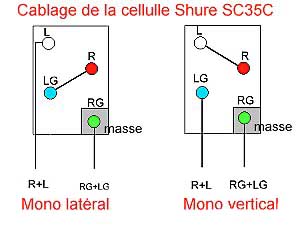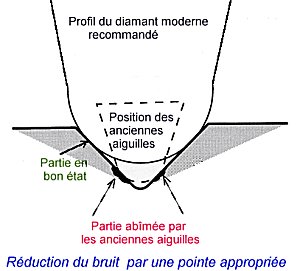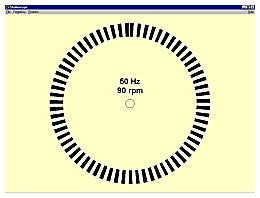Electrical playback of old records
( 78 rpm discs and early microgroove records)
 In spite of the commonly accepted opinion, old records often have a high quality which cannot be imagined when playing them on a vintage machine. The late 78s of the fifties can even be called HI FI .But electrical reproduction is the only way to reveal the quintessence of old recorded sound. As a side effect, it helps saving our precious and irreplaceable sound heritage as it will cause no damage to the fragile recorded surface. And this will allow digital sound processing : getting rid of parasitic noises, improving clarity and finally storing the music safely on a CD (or other digital medium) that will last for ever or perhaps even longer !
In spite of the commonly accepted opinion, old records often have a high quality which cannot be imagined when playing them on a vintage machine. The late 78s of the fifties can even be called HI FI .But electrical reproduction is the only way to reveal the quintessence of old recorded sound. As a side effect, it helps saving our precious and irreplaceable sound heritage as it will cause no damage to the fragile recorded surface. And this will allow digital sound processing : getting rid of parasitic noises, improving clarity and finally storing the music safely on a CD (or other digital medium) that will last for ever or perhaps even longer !
Some specialised dealers (mainly in the USA ) still advertise for excellent 3 speed record decks allowing playback of regular microgrooves and old records. Unfortunately those new high-end machines are rather expensive. A second-hand record player is a more economical choice. With the advent of the CD, many people got rid of their old obsolete record players. You can find them now in second-hand stores or flea markets. You must look for a belt-driven one with a heavy turntable . The Dual 1219 record deck (made during the sixties) is very well adapted to old records playback. Supposing then that you have managed to find a good old three-speed record player of the sixties, with a bit of luck there will be a pitch adjustment allowing to reach the speed of 80 rpm, the speed of most Pathé hill and dale records. Supposing it is fitted with a good magnetic cartridge and a special stylus for 78s, then you are very lucky indeed...
Otherwise, you will have to buy a cartridge and adapt it to the arm. Fortunately, Shure cartridges and 78s diamonds are still available in the year of grace 1999 ! I suggest you purchase the SC35C cartridge, which is robust (commonly used by DJs !) and inexpensive. It works great with 78s and the pressure can be set up to 5 grams which is sometimes required for high-speed tracking.
Monophonic records should be played mono !
This may sound as a truism but modern amplifiers have not been designed for mono playback. Either they don't have a mono/stereo switch and when they have one, it is just a parallel connection of right and left channels. This is not sufficient as the connection must be made at the cartridge level. If you play a mono record in stereo, you will notice that the background noise is not the same on each channel. The music seems to come from the centre but parasitic noises are in stereo ! If you set the switch to mono, the background noise will be centred but it is still here. In fact any stereo cartridge is, by its nature, sensitive to both lateral and vertical motion of the stylus. And a monophonic recording is either purely lateral or purely vertical, while the background noise has both polarisations . Therefore it clearly appears that if we make the cartridge sensitive in only one direction, we will cut 50 % of unwanted noise. The results are often dramatic with 78s and early LPs. This minor miracle is easily obtained by proper wiring of the magnetic cartridge.
Special wiring of a stereo cartridge
 A stereo cartridge consists of two independent channels activated by the same stylus. So you will find 2 connectors per channel. The stylus is free to move vertically, laterally or any intermediate angle. Therefore you can read vertical or lateral recordings (and incidentally stereo which is a mixture of the two). In the case of stereo, a diagonal movement will activate only one channel. The other channel will only be activated by the opposite diagonal movement. Each wall of the groove produces a sound in one loudspeaker only.
A stereo cartridge consists of two independent channels activated by the same stylus. So you will find 2 connectors per channel. The stylus is free to move vertically, laterally or any intermediate angle. Therefore you can read vertical or lateral recordings (and incidentally stereo which is a mixture of the two). In the case of stereo, a diagonal movement will activate only one channel. The other channel will only be activated by the opposite diagonal movement. Each wall of the groove produces a sound in one loudspeaker only.
In order to use this device for mono, the two channels must be linked together to make only one. But instead of using parallel wiring, we will make a series connection. According to the relative phasing of the channels this is what will happen :
-Either the horizontal movements will be added (and vertical response nulled out) : this will allow playback of lateral cut records. -Either the vertical movements will be added (and lateral response nulled out ) : this will allow playback of vertical cut (hill and dale) records such as Pathés and Edison Diamond Discs. If you don't get the expected result at once, just invert the connections on only one channel. Provided that there are actually 4 wires coming out of the cartridge and that the two ground wires are not linked together, a simple polarity inverter on one channel will switch between vertical and lateral . But beware ! sometimes the shielding of the cartridge is grounded through the ground wire of one of the channels, and if by any chance you have selected this channel for the switch, you will get hum and other parasitic noises if you touch the body of the cartridge ! Select the other channel then. That switch must be well shielded ( small metal box) and any additional piece of wire must be as short as possible to avoid possible interference.If you are afraid to butcher your record deck, you can also wire two cartridges on 2 shells, one for vertical and the other for lateral. It will require more manipulations for switching, but what's the hurry anyway ? With a little bit of manual skill and the small diagram here above , it is easy to make the two kinds of wirings.
Important notions on stylus sizes
 Shure still manufactures one model of 78 stylus : the spherical N78S of 0.0025 " (64 microns) . This relatively cheap diamond stylus gives good results with records of the fifties and older records in good condition but if you have very early or badly worn-out 78s, this stylus may not be the best. The tip of the stylus is too small and may reach the bottom of the groove, precisely where the steel needles of the old days have made the worst damage.. In those cases, it is therefore recommended to use a bigger stylus which will be in contact with only the upper part of the groove which is the least damaged part. This is not so simple because the sizes of the grooves have varied considerably between 1900 and 1955. People who remaster 78s professionally actually use a wide variety of styli according to the age and condition of the records. As those "custom-made" diamond styli are rather expensive, the average amateur will use three or four styli, which will allow playback of all records. As far as I know, the British "Expert Stylus Company" is the only one that manufactures those special types of styli. They are of the "truncated conical" type, i.e. the tip is not spherical but flattened so that it cannot reach the bottom of the groove. Their only problem is the price : around 450 FF on average. But try to cut and polish diamonds of a few thousandths of an inch ! Good luck !
To sum up, here are the 4 stylus sizes which are a good trade-off to play all lateral cut records.
Shure still manufactures one model of 78 stylus : the spherical N78S of 0.0025 " (64 microns) . This relatively cheap diamond stylus gives good results with records of the fifties and older records in good condition but if you have very early or badly worn-out 78s, this stylus may not be the best. The tip of the stylus is too small and may reach the bottom of the groove, precisely where the steel needles of the old days have made the worst damage.. In those cases, it is therefore recommended to use a bigger stylus which will be in contact with only the upper part of the groove which is the least damaged part. This is not so simple because the sizes of the grooves have varied considerably between 1900 and 1955. People who remaster 78s professionally actually use a wide variety of styli according to the age and condition of the records. As those "custom-made" diamond styli are rather expensive, the average amateur will use three or four styli, which will allow playback of all records. As far as I know, the British "Expert Stylus Company" is the only one that manufactures those special types of styli. They are of the "truncated conical" type, i.e. the tip is not spherical but flattened so that it cannot reach the bottom of the groove. Their only problem is the price : around 450 FF on average. But try to cut and polish diamonds of a few thousandths of an inch ! Good luck !
To sum up, here are the 4 stylus sizes which are a good trade-off to play all lateral cut records.Pre 1920 acoustical records: 0.0040'' (100 microns)
Records between 1920 and 1939 : 0.0035'' ( 90 microns)
Records after 1939 : 0.0028'' ( 71 microns) Early microgrooves : 0.001'' ( 25 microns)
(N.B. The Americans refer to stylus sizes in thousandths of inches in the following format: "2.5 mil", which is equivalent to 0.0025" in U.K. and 64 microns in civilised countries !)
With those 4 stylus sizes, the serious amateur will be able to get the best from most records.
Problems with hill and dale discs
Pathé hill-and-dale discs, very common in France, are easy to playback electrically if the cartridge has been wired for that purpose. Early Pathé discs are centre-start but they spin clockwise like any others so you won't have to make your turntable rotate the wrong way round ! Those records are very tolerant with styli : a specially designed stylus would certainly be fine but in fact any regular 78 stylus will just be all right. You will perhaps get more surface noise but also more high frequency response which is not a bad thing. The only problem with hill and dale discs is the shallow groove. With the antique reproducers (weighing more than 100 grams !) it was right but with our modern lightweight cartridge (weighing no more than 5 grams) the surface of the record is a real skating rink! And the only way to cope with it is by using the "anti-skating". Most good record decks are equipped with this device but it has to be properly adjusted. In order to do so, you will need a disc without any grooves, e.g. the back of a single-sided Gramophone record. Place the stylus in the middle of that silent record and start the turntable at the correct speed. Then turn the button (or thumbwheel) of the anti-skating until the stylus stays stable and does not slip to the centre or the outside of the disc. You must note that this adjustment is only valid for a specific speed. If you change the speed you must re-adjust the anti-skating again.
Speed problems
78s do not all spin at 78 rpm ! It is just that we have taken the habit of calling 78s any pre-microgroove record...Early 1900 acoustical discs would rotate somewhere between 60 and 75 rpm and some specialists will debate if Caruso did not sing one semitone higher in such and such recording.... the kind of important questions that will perhaps remain unanswered ! Concerning early Pathé verticals, the speed was between 90 and 120 rpm, before a standard 80 rpm was adopted. All mechanical gramophones and electrical "pick-ups" had a continuous speed adjustment allowing any possible speed...Adjustment was done by ear ! But as we have become purists, we will use stroboscopes calibrated for the various speeds of early records. Making stroboscopes for any speed is easy with the nice little freeware by Jean Vernet from Morges, Switzerland, called STROBO.EXE

You just select the speed you want and the mains frequency: 50 Hz in Europe, 60 Hz in America. Print a few strobes on pieces of card : 78, 80, 90 rpm are the most useful ones.
Most turntables with a pitch control will rotate up to 80 rpm but no faster. Only professional record decks (with a professional price tag !) have continuous speed control from 15 up to 120 rpm. I personally use a special turntable which plays 90 rpm records only. I made it with a 33/45 belt-driven turntable of the 70ies by only changing the diameter of the pulley. It works very well and did not cost me an arm and a leg ! Another way of coping with the speed problem is by using some kind of Audio processing software like Cool Edit or DC Art. The program allows to modify the speed of the sound files, for instance you can record a 90 rpm record at 78 rpm and easily speed it up to sound like it should do.
Weight and tracking problems
Old acoustical reproducers commonly weighted more than 100 grams and combined with used needles caused terrible damage to records. The only good thing is they would keep in the groove and not take off with warped records ! It is not the case with a modern turntable and a lightweight stylus. We will therefore use the maximum pressure recommended by the cartridge manufacturer. 5 grams is sensible with most 78 s. 2 grams will be enough for mono LPs. If you care to clean your records, the diamond will last a very long time and you will cause no damage to the recorded surface.
Problems with various disc sizes
The vast majority of old records have a maximum diameter of 30 cm. But it you want to play the -not too rare - 35 cm Pathé records, you will probably need to modify the record deck slightly. On the Dual 1219, you will just have to remove the arm-rest which is only screwed to the chassis. . But of course, no modern turntable will play the -quite rare- 50 cm Pathé records. In fact, the most problematic records are the small ones because the recorded section comes very near to the centre, well beyond the auto-stop point. So if you want to play Berliners, the Dual 1219 is not a good choice. You must choose a manual turntable with an arm capable of reaching the centre.
Cleaning records
I have kept the least technical things for the end, but this is perhaps the most important and it can improve playback dramatically, either with 78s or with LPs. Old records ALWAYS need some cleaning ! First it will save your expensive stylus from dirt which always contains abrasive elements and it will also eliminate a lot of parasitic noise. A small carbon fibre brush is useful to remove dust from clean records, but this is not sufficient for old records found on the pavement at a flea-market. Only a "good washing-up" can remove dirt from the bottom of the grooves. Lukewarm water with a few drops of dish washing liquid is the only advisable product. Never use alcohol or any chemical solvent which would ruin the recorded surface forever! Never use HOT water which might result in severe warping ! That said, you can wash and rinse the records until all traces of detergent have been eliminated. Don't allow the records to dry by themselves especially if you have hard water but dry them with a clean piece of cloth. Some humidity will remain at the bottom of the grooves so allow them to dry (of course not in direct sunlight!) Purists will object that total immersion of a record may cause the central label to go away or to become warped. Perhaps some brands of records have that possible problem, but I must say I never managed to remove the label of a 78 that way, even when trying hard. One thing is sure anyway: you must never put the record back into its paper sleeve before it is totally dry...
A last piece of advice ...and common sense ! Broken or deeply cracked records should NOT be played at all with a modern lightweight cartridge. Your precious truncated conical diamond stylus would not like it at all ! Play them on an old Gramophone if you really want to know what's on it...